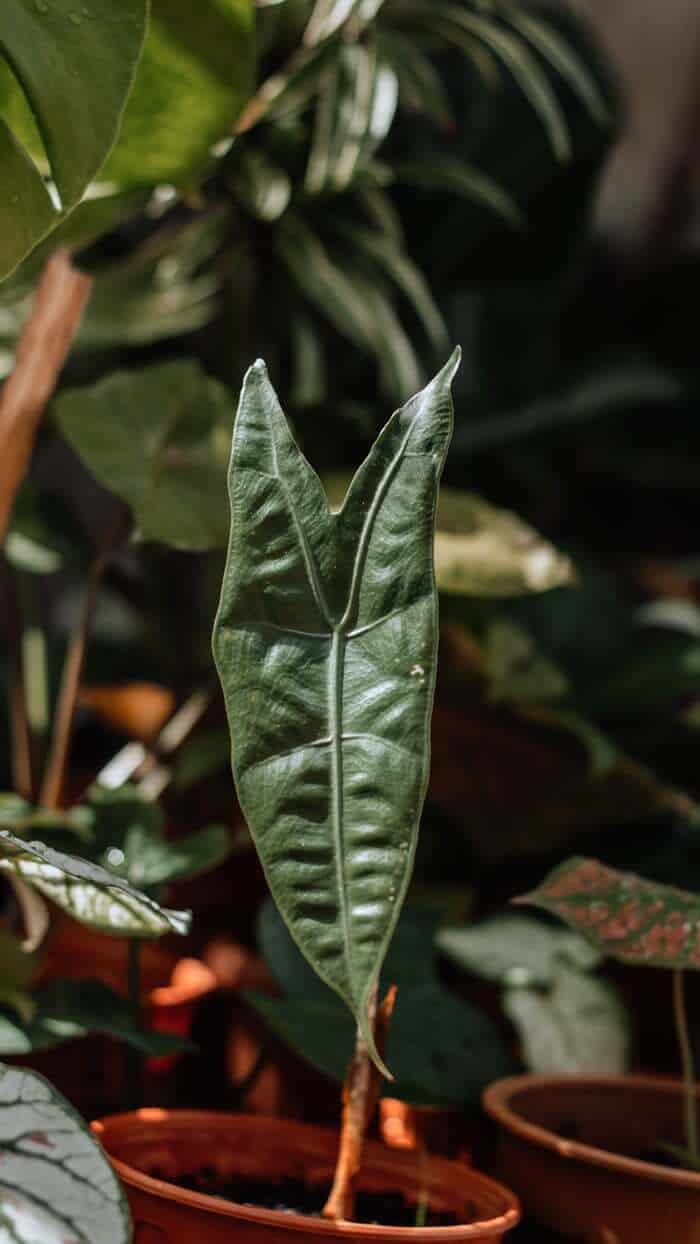Last Updated on May 9, 2023 by a Friendly Gardener
The Alocasia is a visually striking tropical plant appreciated for its lovely foliage. It can be found growing in tropical and sub-tropical areas of Eastern Australia, the Philippines, the South Pacific Islands, and some parts of Asia. It has several popular names including the “African Mask” in reference to the striking leaves but is best known as “Elephant Ears”. The Alocasia is a popular houseplant despite its tropical nature and is a favorite in non-tropical climates as well.
You can opt to grow one outdoors in warmer months or climates. Many home gardeners bury the plant directly in the garden bed while still in its pot with success.
Alocasias are rapid growers, hence outside, they are often labeled as invasive as in the United States gulf coast area. For outdoor cultivation check for restrictions in your area.
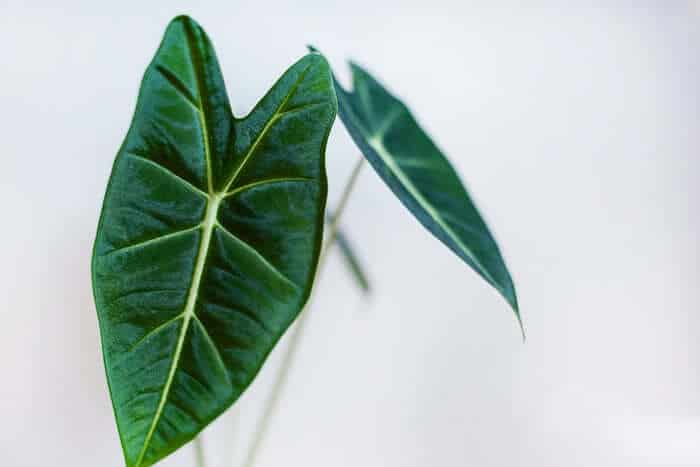
The Alocasia is a member of the Araceae family. A perennial rhizomatous plant, it will flower. Stunning leaves grow at stem ends that can extend from three to five feet long. Stems emerge from the plant’s base and leaves may point either up or down. Leaf direction will depend on the Alocasia species.
Many alocasia cultivars do well in shade but thrive in bright filtered sunlight. Large Alocasia cultivars will weather full tropical sun when hardened. Alocasias need humid warm environments, and to remain moist. The Alocasia will flower and produce a light yellow non-showy bloom.
Alocasia is potentially invasive with new roots that sprout from their nodes. New stems emerge from rhizomes. Invasive plants with rhizomes are often difficult to eradicate as even a tiny piece of rhizome can produce a new plant.
Alocasia Plant Care

As rapid growers, Alocasia can produce a new leaf weekly and new foliage may be larger. Foliage is generally heart-shaped or has a narrow arrowhead design. Colorful veins decorate leaves that can be waxy, or glossy.
Come autumn, the Alocasia enters dormancy. It will not grow as long as it sleeps. Continue with primary care as growth will take off once it awakens.
Soil
Loose, well-draining potting soil is ideal, or a crumbly loamy textured soil. The soil pH should be slightly acidic between 5.5 and 6.5. If you wish to create a soil mix, use potting soil that is porous and add in one part peat and one part perlite. Outdoors you can cultivate in sandy or loamy soil as well as clay.
Light
Depending on the variety of Alocasia, lighting will vary. When purchasing a cultivar, ask if it is trained for direct sun. Foliage will appear healthier with vibrant color in brighter light.
The Alocasia as a rule of thumb prefers bright indirect light as in its natural habitat. Alocasias grow on the tropical forest floor beneath a tree canopy. So, generally, direct sunlight scorches their famous foliage. They do not usually thrive in low-light conditions. Rotate your Alocasia regularly for balanced growth.
Water
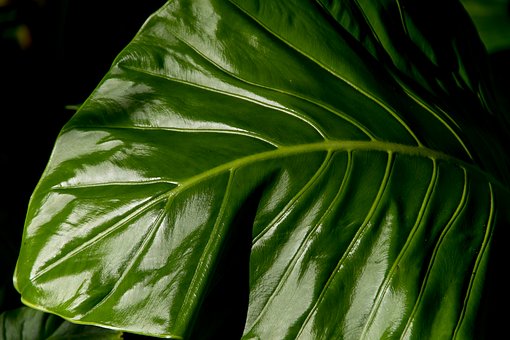
Your Elephant Ear loves water so the soil must be consistently moist but not soggy. During winter dormancy water can be reduced. Allow the soil’s top two inches to dry before watering. Soggy soil can lead to fungal infections and diseases. Drainage should be good and remove excess water.
Alocasias can be soaked in a bathtub, shower, or sink. Fill a tub with three to four inches of tepid water. Let your plant sit in the tub for approximately an hour to soak up water through the container’s drainage holes. Water should arrive at the soil bed surface. If not, water from the top for balanced saturation. Let your Alocasia drain thoroughly after soaking.
Humidity
The tropical Alocasia loves humidity. Use a space humidifier or a pebble tray if your home’s air is a bit dry. Fill the tray with pebbles and water so that it arrives below the pot’s bottom. Misting on a regular basis will also aid but will not resolve humidity problems.
Temperature
The Alocasia does not tolerate temperatures below 60° Fahrenheit. A few Alocasia cultivars will die back during the winter only to rejuvenate in the spring. Alocasias also suffer from cold drafts, so they need to be positioned away from windows, doors, air conditioning vents, and heaters. These plants do not survive in cold winters or arid climates.
Feeding the Alocasia
Use a quality liquid fertilizer monthly during the growing season.
Pruning and Repotting

Repot your Alocasia annually into a larger pot with fresh well-draining soil. During repotting divide the rhizome to keep your plant at a manageable size.
Pests, Diseases, and Problems
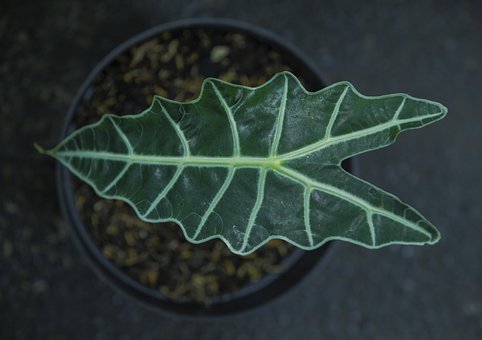
Alocasia is sensitive to various diseases. Common illnesses include:
- Crown, stem, or root rot
- Leaf spot
- Xanthomonas
Yellow-edged dark brown or black spots on foliage are indicative of illness. Alocasia plants must not be overwatered. Foliage should remain dry with good air circulation where the plant is positioned.
Yellow leaves may indicate a moisture problem or overwatering, while yellow or brown leaves indicate root rot.
Scorched foliage indicates excessive exposure to direct sunlight. With insufficient light, the leaves turn yellow.
Brown-edged foliage that droops indicates low humidity. Without correction, the leaf will turn yellow, brown, and finally shrivel. Forgetting to water will dry out the soil bed and the leaves will appear limp.
With new growth, older leaves turn yellow, particularly at the plant’s base. Simply remove these.
Pests that infest the Alocasia include:
- Scale
- Mealybugs
- Aphids
- Spider mites
Maintain foliage free of dust. For pest infestation, apply organic Neem oil, an all-purpose pesticide, fungicide, and miticide. It works for both pests and eggs. Because Neem oil works on the entire plant system, the Alocasia absorbsNeem oil into its circulatory system to poison pests inside the plant.
Alocasia Toxicity

Alocasia is extremely toxic because it contains oxalate crystals. If chewed, bitten, or ingested, oxalate crystals are released. These crystals will irritate the mouth causing swelling and throat and gastrointestinal tract distress. Severe swelling can close the upper airway making breathing difficult. PlaceAlocasia plants away from children and pets. For suspected Alocasia poisoning contact your veterinarian, your doctor, or your local poison control center immediately.
Oxalate crystal poisoning symptoms include:
- Excessive drooling
- Vomiting
- Mouth pain
- Swelling
- Nausea
- Diarrhea
- Loss of appetite
- Mouth and throat blistering
Alocasia Propagation
The Alocasia is best propagated by cutting a piece of the rhizome buried underground. Plant the rhizome section in a different spot or container with well-draining loose soil. Maintain warmth and moisture until a new plant sprouts.
In Conclusion
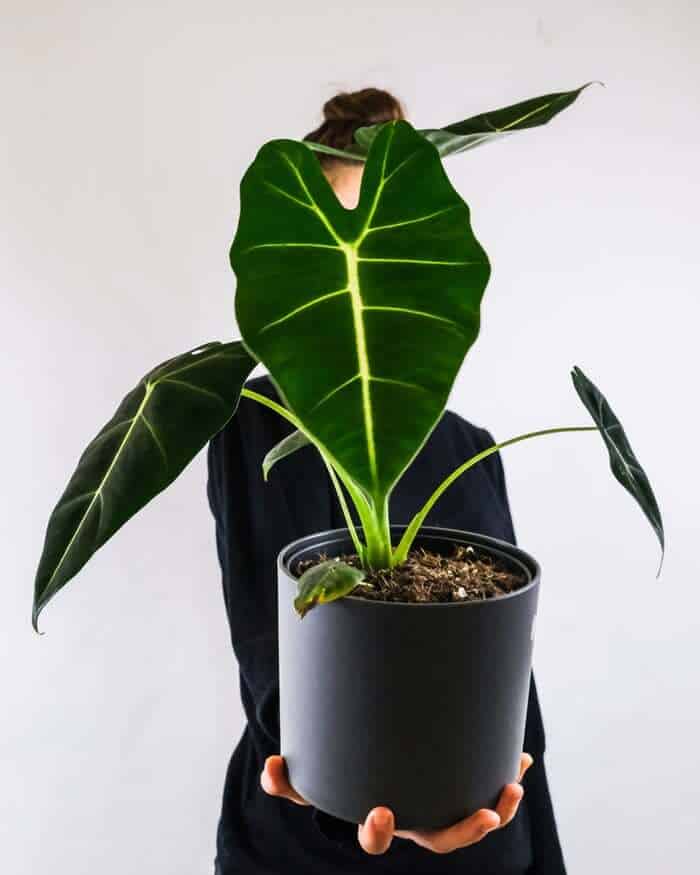
The Alocasia is well-loved as a houseplant for its dramatic foliage. Its sculptural form and visual appeal make it a stunning addition to a home or office décor. This is truly a statement plant regardless of where you position it and a beautiful, healthy Alocasia will attract attention and conversation. If you enjoy larger houseplants and have the space, consider this striking tropical species. It particularly lends itself to lobbies, hallways, waiting rooms, conservatories, and large living rooms.

